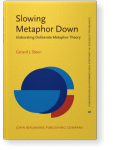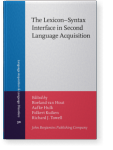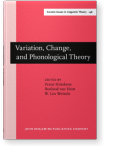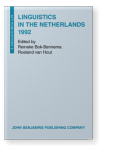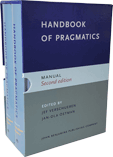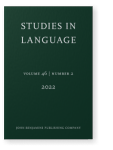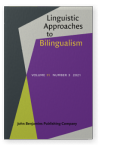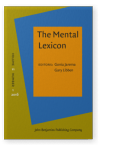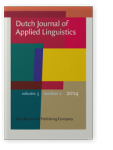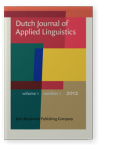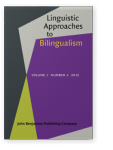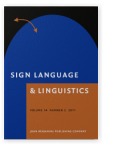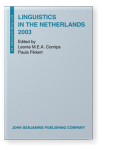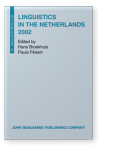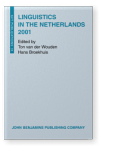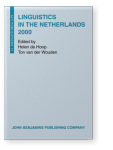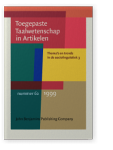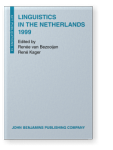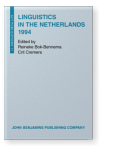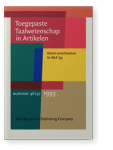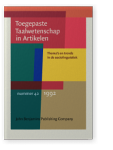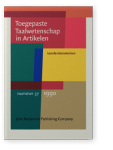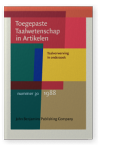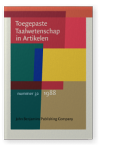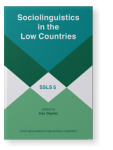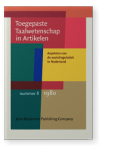Roeland van Hout
List of John Benjamins publications for which Roeland van Hout plays a role.
Book series
Titles
The Lexicon–Syntax Interface in Second Language Acquisition
Edited by Roeland van Hout, Aafke Hulk, Folkert Kuiken and Richard J. Towell
[Language Acquisition and Language Disorders, 30] 2003. viii, 234 pp.
Subjects Language acquisition | Semantics | Syntax
Variation, Change, and Phonological Theory
Edited by Frans Hinskens, Roeland van Hout and W. Leo Wetzels
[Current Issues in Linguistic Theory, 146] 1997. x, 314 pp.
Subjects Historical linguistics | Phonology | Sociolinguistics and Dialectology
Linguistics in the Netherlands 1992
Edited by Reineke Bok-Bennema and Roeland van Hout
[Linguistics in the Netherlands, 9] 1992. x, 284 pp.
Subjects Theoretical linguistics
2022 Statistics Handbook of Pragmatics: Manual, Verschueren, Jef and Jan-Ola Östman (eds.), pp. 1763–1767 | Chapter
2022 Stability and change in the colour lexicon of the Japonic languages Studies in Language 46:2, pp. 323–351 | Article
Previous work on colour lexicons focussed on universal patterns in their structure and evolution. We collected new colour naming data in Japanese and three under-described Ryukyuan languages (Amami, Miyako and Yaeyama) to investigate semantic variation and change in the colour lexicon of related… read more
2021 Differences in phonological awareness performance: Are there positive or negative effects of bilingual experience? Linguistic Approaches to Bilingualism 11:3, pp. 418–451 | Article
Children who have knowledge of two languages may show better phonological awareness than their monolingual peers (e.g. Bruck & Genesee, 1995). It remains unclear how much bilingual experience is needed for such advantages to appear, and whether differences in language or cognitive skills alter… read more
2016 Transitivity in similarity judgments on German verbs: Disclosing lexical and aspectual properties of verbs The Mental Lexicon 11:1, pp. 76–93 | Article
This paper investigates set-theoretical transitive and intransitive similarity relationships in triplets of verbs that can be deduced from raters’ similarity judgments on the pairs of verbs involved. We collected similarity judgments on pairs made up of 35 German verbs and found that the concept… read more
2015 Is Moroccan-flavoured Standard Dutch standard or not? On the use of perceptual criteria to determine the limits of standard languages Responses to Language Varieties: Variability, processes and outcomes, Prikhodkine, Alexei and Dennis R. Preston (eds.), pp. 191–218 | Article
In view of the fact that Netherlandic Standard Dutch has been found to be stratifying – i.e. incorporating regional accent variation to allow speakers to profile local group membership in addition to their national affiliation – an evident question is whether non-Dutch accents are also tolerated in… read more
2015 Got class? Community-shared conceptualizations of social class in evaluative reactions to sociolinguistic variables Responses to Language Varieties: Variability, processes and outcomes, Prikhodkine, Alexei and Dennis R. Preston (eds.), pp. 159–174 | Article
In recent years, researchers have successfully used information about cultural identity and consumption behavior to uncover class-based variation in linguistic production data. Is this variation reflected in implicit class-related language attitudes, of which listeners may not even be aware? And… read more
2014 Data curation for a VALID Archive of Dutch Language Impairment Data Dutch Journal of Applied Linguistics 3:2, pp. 127–136 | Article
The VALID Data Archive is an open multimedia data archive in which data from children and adults with language and/or communication problems are brought together. A pilot project, funded by CLARIN-NL, was carried out in which five existing data sets were curated. This pilot enabled us to build up… read more
2012 Where is Dutch (really) heading? The classroom consequences of destandardization Dutch Journal of Applied Linguistics 1:1, pp. 41–58 | Article
Like other European standard languages, Dutch is currently undergoing destandardization processes which excite concern on the part of the linguistic and cultural establishment, and inspire uncertainty in school teachers of Dutch. In the face of the progressing variability in a variety which should… read more
2012
Dutch nouns are divided into two groups according to grammatical gender which is, among others, marked on the definite determiner: common nouns take the definite determiner de and neuter nouns take the definite determiner het. This study is unique in systematically investigating the acquisition of… read more
2011 Variation in mouth actions with manual signs in Sign Language of the Netherlands (NGT) Sign Language & Linguistics 14:2, pp. 248–270 | Article
Mouthings and mouth gestures are omnipresent in Sign Language of the Netherlands (NGT). Mouthings in NGT commonly have their origin in spoken Dutch. We conducted a corpus study to explore how frequent mouthings in fact are in NGT, whether there is variation within and between signs in mouthings,… read more
2003 10. The interface: Concluding remarks The Lexicon–Syntax Interface in Second Language Acquisition, Hout, Roeland van, Aafke Hulk, Folkert Kuiken and Richard J. Towell (eds.), pp. 219–226 | Chapter
2003 An acoustic study of standard Dutch /v/, /f/, /z/ and /s/ Linguistics in the Netherlands 2003, Cornips, Leonie and Paula Fikkert (eds.), pp. 93–104 | Article
2002 Loan words as markers of differentiation Linguistics in the Netherlands 2002, Broekhuis, Hans and Paula Fikkert (eds.), pp. 163–173 | Article
2001 The devoicing of fricatives in a reading task Linguistics in the Netherlands 2001, Wouden, Ton van der and Hans Broekhuis (eds.), pp. 219–229 | Article
2000 N-deletion in reading style Linguistics in the Netherlands 2000, Hoop, Helen de and Ton van der Wouden (eds.), pp. 209–219 | Article
1999 Waarom Veroveren 'Hun' Onze Taal? Sociale en taalkundige verklaringen voor de opkomst van een subjectspronomen Thema's en trends in de sociolinguïstiek 3, pp. 73–86 | Article
Like English, Dutch has a case distinction in the pronoun of the third person plural. English makes a distinction between they versus them, Dutch distinguishes zij and hen/ bun (in addition to the reduced forms ze). Nowadays, hun occurs frequently in large areas of the Netherlands as a subject… read more
1999 The Pronunciation of (r) in Standard Dutch Linguistics in the Netherlands 1999, Bezooijen, Renée van and René Kager (eds.), pp. 177–188 | Article
1997 Balancing Data and Theory in the Study of Phonological Variation and Change Variation, Change, and Phonological Theory, Hinskens, Frans, Roeland van Hout and W. Leo Wetzels (eds.), pp. 1–33 | Article
1995 Statistics Handbook of Pragmatics: Manual, Verschueren, Jef, Jan-Ola Östman and Jan Blommaert † (eds.), pp. 624–627 | Article
1994 Dimensional spatial relations in adult language acquisition Linguistics in the Netherlands 1994, Bok-Bennema, Reineke and Crit Cremers (eds.), pp. 235–246 | Article
1992 Preface Linguistics in the Netherlands 1992, Bok-Bennema, Reineke and Roeland van Hout (eds.), p. | Article
1992 Voorwoord Thema's en trends in de sociolinguistiek, pp. 3–4 | Article
1992 De Sociolinguïstiek In het Nederlandse Taalgebied Anno 1991 Thema's en trends in de sociolinguistiek, pp. 7–16 | Article
This contribution discusses the state of affairs of sociolinguistics in the Dutch language area. The discussion is particularly based on the conference papers in the proceedings of the "First Conference on Sociolinguistics", which was organized in November 1991. This conference was meant to be the… read more
1990 Individuele Verschillen in Het Leren Van Talen: Ontwikkelingen in Theorievorming en Onderzoek Leerderskenmerken: Individuele verschillen in het leren van talen., pp. 5–14 | Article
This contribution gives a global introduction into recent developments in theory and research on individual differences in language learning. It attempts to outline a more general framework for the contributions in this volume on learner differences. The following five questions are focused upon:… read more
1988 Spontane Taaldata en het Meten van Lexicale RIJKDOM I Tweede-taalverwerving Taalverwerving in onderzoek, pp. 67–80 | Article
Increasing use of spontaneous speech data in second language re-search made it necessary to use other measures than tests for getting insight into the lexical richness of (spoken) text corpora of second language learners. In this article several lexical measures (types, TTR(c), Guiraud, logTTR,… read more
1988 Spontane Taaldata En Het Meten Van Lexicale Rijkdom In Tweedetaalverwerving Toegepaste Taalwetenschap in Artikelen 32, pp. 108–122 | Article
Increasing use of spontaneous speech data in second language research made it necessary to use other measures than tests for getting insight into the lexical richness of (spoken) text corpora of second language learners. In this article several lexical measures (types, TTR, TTR(c), Guiraud,… read more
1984 Sociolinguistics in the Netherlandic language area Sociolinguistics in the Low Countries, Deprez, Kas (ed.), pp. 1–42 | Miscellaneous
1980 De Studie Van Stadsdialekt: Van Dialektologie, Empirische Linguistiek en Sociolinguistiek Aspekten van de sociolinguistiek in Nederland: 22 maart 1980 te Amsterdam, pp. 143–162 | Article
From the beginning, sociolinguistics has mainly been focusing on the study of urban dialects. The sociolinguistic approach seems to complement dialectology, as dialectology is mainly oriented towards rural dialects. However, this vision of dialectology (oriented towards the rural part of society)… read more
